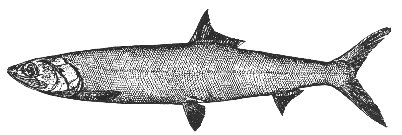Ten pounder Elops saurus Linnaeus 1766
[Jordan and Evermann, 1896-1900, p. 410.]

Figure 38.—Ten pounder (Elops saurus), From Goode. Drawing by H. L. Todd.
Description—
The ten pounder is herring-like in the arrangement of its fins, with the single and soft-rayed dorsal fin originating about midway along its back; in having no adipose fin; in the position of its ventral fins about midway between tip of snout and fork of tail; and in its forked-tail fin. But its scales are very much smaller relatively than those of any of our herrings, and its mouth is much larger, with the upper jawbone extending rearward considerably beyond the rear edge of the eye. Being about one-sixth as deep as it is long, it is a much more slender fish than any of our herrings except the round herring, and its belly is rounded like that of the latter. But its trunk is more flattened sidewise than that of the round herring, its dorsal fin-origin is over the ventrals (well in advance of the ventrals in the round herring), and its tail fin is much wider relatively than that of any herring, and more deeply forked.
A more important structural character is that its throat is stiffened between the branches of its lower jaw by a long bony plate, which it shares with the tarpon, but which no member of the herring tribe has. Its closest affinity among fishes yet known from our Gulf is with the tarpon. But its scales are very much smaller than those of the latter, nor does its dorsal fin have the prolonged ray characteristic of the tarpon.
Color—
Silvery all over, with the back bluish, the lower parts of the sides and the lower surface yellowish; the dorsal and caudal fins dusky yellowish and silvery; the ventral and pectoral fins yellowish speckled and dusky.
Size—
The ten pounder is said to grow to a length of 3 feet,[12] but few of those caught are longer than about 20 inches.
General range—
Atlantic coast of America, from Brazil northward; commonly to North Carolina, in small numbers and less regularly to southern New England, and perhaps straying around the elbow of Cape Cod on rare occasions. The ten pounder of our Atlantic coast is represented in tropical-warm temperate seas in various other parts of the world by relatives so close that they may all finally prove to represent only the one wide-ranging species.[13] Our only reason for mentioning this southern fish is that one reported as from Chatham, Mass., may have been taken on the Gulf of Maine shore of Cape Cod.[14] Ten pounders are taken from time to time near Woods Hole.
[12] Jordan and Evermann, Bull. 47, U. S. Nat. Mus., Pt. 1, 1896, p. 410.
[13] Smith (Sea Fishes Southern Africa, 1949, p. 86) considers this probable.
[14] This specimen, taken on October 19, 1888, and reported by Bigelow and Schroeder (Copeia, 1940, p. 139) is in the Museum of Comparative Zoology.